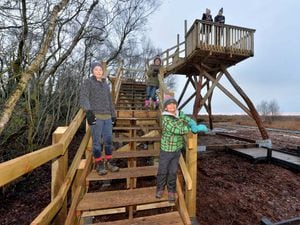WATCH: Tower gives a bird's eye view of the landscape
An impressive structure has appeared on one of Shropshire’s nature reserves, giving visitors a bird’s eye view of the landscape.

Standing five metres high, the Mammoth Tower has been erected at the Fenn’s and Whixall Mosses, part of the 2,500 acre Marches Mosses.
It is the first part of a new outdoor centre, with interpretation boards, which will help visitors to understand the creation, near-destruction and regeneration of the Mosses, as well as learn more about the value of the peat the tower stands on in the fight against the climate change crisis.
Shropshire Wildlife Trust are leading the Mammoth Tower development as part of the overall BogLIFE project to regenerate the Mosses and provide more opportunities for visitors to share the mystery and the magic of the Mosses.
Helen Trotman of Shropshire Wildlife Trust said: “We’re thrilled that the tower is complete and visitors can experience the view of the Mosses from the top of the tower. It truly gives people a bird’s eye view of the awesome expanse of the Mosses.
"The viewing platform is the first of a series of new installations that are aimed at improving the experience for visitors. We’re currently developing the interpretation that will support the platform and which will be in place by next summer.”
The Mammoth Tower is a short walk along the Llangollen Canal towpath from Morris’ Bridge car park.
Fenn’s and Whixall National Nature Reserve manager Pete Bowyer said it was an important new structure on the mosses.
He said the Marches Mosses were the third-largest lowland raised bog in Britain which, until peat cutting and drainage began covered an area five miles long with large domes of peat rising up to eight metres above the surrounding landscape.
“Over a third of this peatland has been lost due to human activities over the centuries.”
“The work of the past 30 years has helped to restore damage done over centuries. The Mosses are a rare habitat with a wide range of wildlife, a huge carbon store and a wonderful place for people to enjoy an incredible, tranquil day out.”
Those involved in regenerating the peat at the The Marches Mosses say the work is helping in the fight against the climate crisis by storing more carbon.
“Peat stores more carbon per acre than trees do. Restoring the peat creates additional depth of peat which in turn stores even more carbon. Conversely, allowing peatlands to dry out releases that stored carbon into the atmosphere,” Mr Bowyer said.
During the Second World War the area was used as a decoy site. Fires were lit on the moss to trick enemy pilots into thinking that they were over Liverpool and drop their bombs onto the moss instead of the city.





